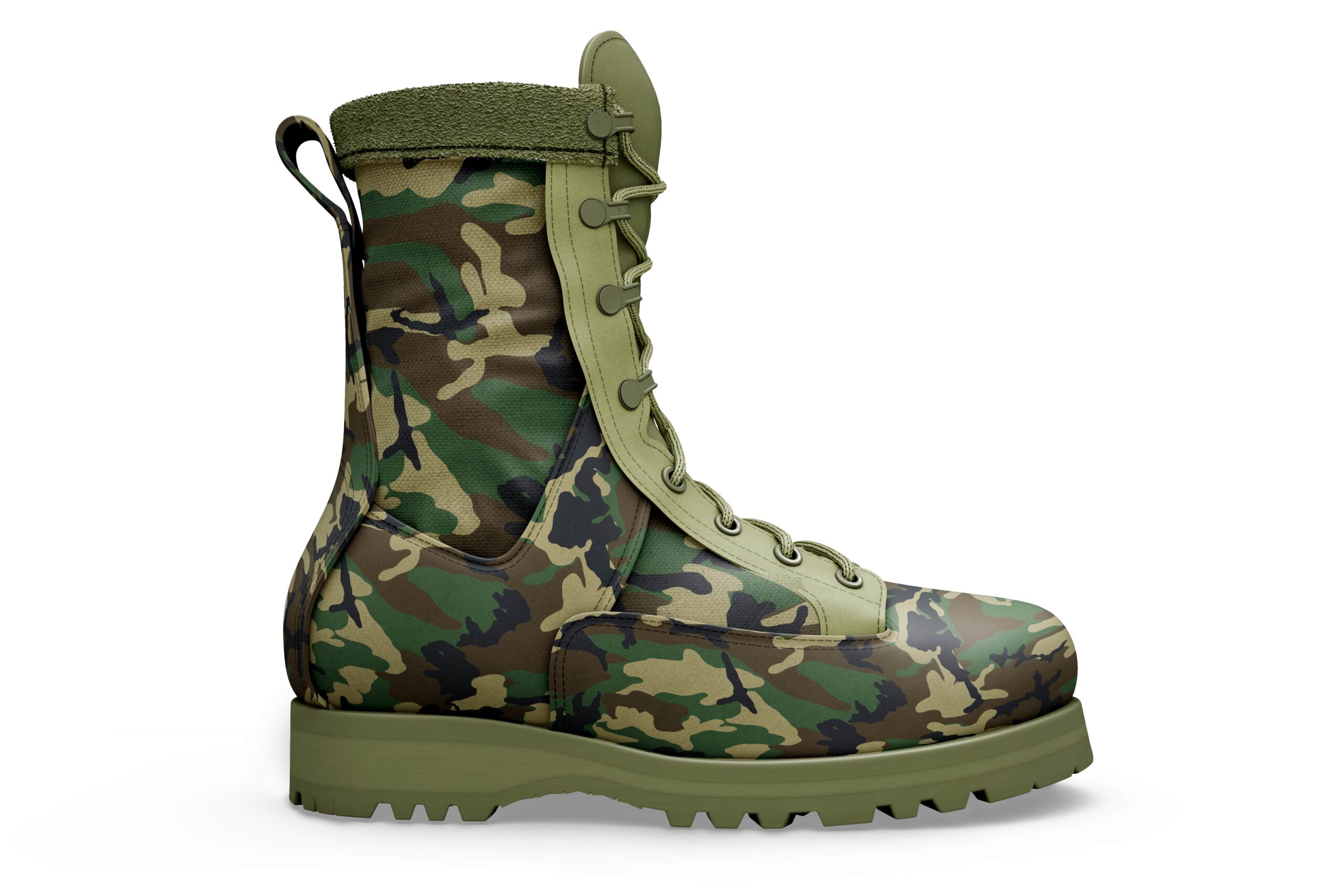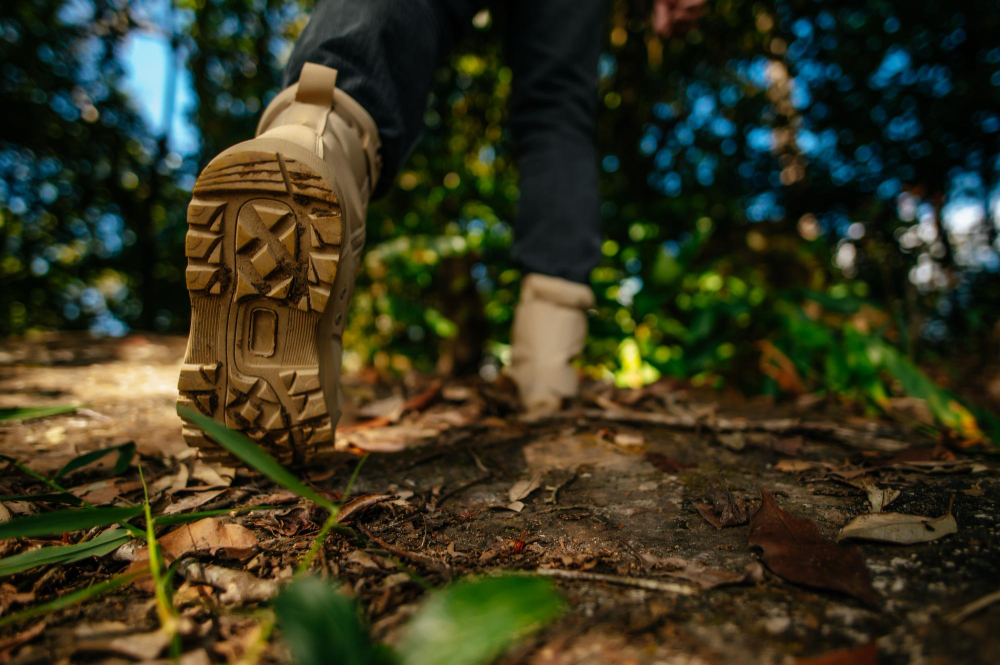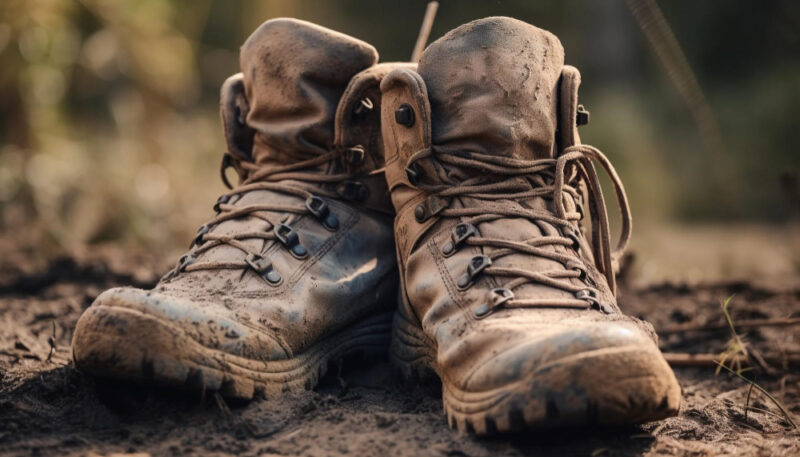Hunting boots are specifically tailored to meet the demands of hunters, providing insulation, camouflage options, scent control technology, and durability in rugged terrains. Hiking boots are designed for comfort and stability on various trails.
Hunting Boots

Hunting boots are specifically designed to provide maximum comfort and protection in rugged outdoor environments.
One key feature of hunting boots is their insulation. These boots often come with various insulation options, such as Thinsulate or Gore-Tex lining, which help keep your feet warm during cold weather hunts.
Another important aspect of hunting boots is their durability. They are built to withstand tough terrains and harsh conditions, ensuring that they won’t let you down when you need them the most.
Hunting boots often have specialized features like scent control technology. This helps mask human scent and prevents animals from detecting your presence while on the hunt.
Features of hunting boots
- Camouflage
- Waterproof/Water-Resistant
- Scent Control
- Durability
- Support and Stability
Hiking Boots

Hiking boots are specifically designed to provide comfort, support, and protection for your feet on rugged terrains. They come in various types such as trail shoes, day hiking boots, and backpacking boots.
Trail shoes are lightweight and flexible, perfect for easy trails or casual hikes. Day hiking boots offer more ankle support and stability for longer treks with moderate terrain. Backpacking boots are heavy-duty and durable, designed for multi-day trips carrying heavy loads.
Hiking boots typically have a sturdy sole with good traction to prevent slipping on slippery surfaces. They also feature cushioning in the midsole to absorb shock during long hikes. The upper part of the boot is made from breathable materials like leather or synthetic fabrics to keep your feet dry and comfortable.
Features of hiking boots
- Traction
- Comfort and Cushioning
- Durability
- Breathability
- Ankle Support
Hunting boots Vs. Hiking boots – Key differences
Hunting Boots:
- Insulation: Hunting boots often have insulation to provide warmth in cold weather conditions, as hunters may spend long periods outdoors.
- Camouflage: Many hunting boots come in camouflage patterns to help hunters blend into their surroundings and remain undetected by wildlife.
- Scent Control: Hunting boots may feature specialized materials or treatments to reduce odor and scent, which can help prevent animals from detecting human presence.
- Waterproofing: Hunting boots are often designed to be waterproof or water-resistant, as hunters may encounter wet or muddy environments during their activities.
- Support and Stability: Hunting boots are designed to offer support and stability, as hunters may navigate uneven terrain or carry heavy loads.
Hiking Boots:
- Versatility: Hiking boots are designed for various outdoor activities, including hiking, trekking, and backpacking.
- Durability: Hiking boots are typically constructed with durable materials to withstand rugged terrains and provide long-lasting performance.
- Traction: Hiking boots offer reliable traction on different surfaces, including rocks, trails, and slippery conditions, to ensure secure footing.
- Comfort and Cushioning: Hiking boots prioritize comfort and cushioning to provide all-day comfort during long hikes.
- Breathability: Hiking boots often have breathable materials and ventilation features to promote airflow and prevent excessive sweating.
While there may be some overlap in features, these differences reflect the specific needs and priorities of hunters and hikers. It’s important to choose the appropriate footwear based on the intended activity and environmental conditions.
| Hunting Boots | Hiking Boots |
|---|---|
| Camouflage patterns for blending in | No camouflage patterns |
| Scent control to reduce detection by animals | No specialized scent control |
| Waterproof or water-resistant for wet conditions | Waterproof or water-resistant for hiking conditions |
| Designed for rugged terrains and obstacles | Designed for various terrains and trails |
| Insulation for warmth in cold weather | Generally lighter and more breathable |
| Support and stability for uneven terrains | Support and stability for long-distance hikes |
Types of hiking boots
Trail Shoes: These are lightweight and flexible shoes ideal for day hikes on well-maintained trails. They offer good traction and comfort but may lack ankle support.
- Day Hiking Boots: Designed for moderate terrain, these boots provide better ankle support compared to trail shoes. They often have stiffer soles for added stability during longer hikes.
- Backpacking Boots: Built for multi-day trips carrying heavy loads, backpacking boots offer excellent ankle support, durability, and protection against rough terrains.
- Mountaineering Boots: As the name suggests, these boots are engineered for mountaineering or climbing challenging peaks with extreme conditions like snow or ice. They feature rigid soles and crampon compatibility.
- Waterproof Hiking Boots: Perfect for wet environments or rainy climates, waterproof hiking boots use specialized membranes that keep your feet dry while still allowing breathability.
- Minimalist Hiking Shoes: For those who prefer a more natural feel while hiking, minimalist shoes provide minimal cushioning and a low-profile design that enhances ground contact.
Remember that choosing the right type of hiking boot depends on factors such as your activity level, terrain difficulty, weather conditions, personal preference in terms of weight versus ankle support needed.
Types of hunting boots
- Insulated Hunting Boots: These boots feature insulation to provide warmth in cold weather conditions, making them suitable for winter or colder climates.
- Waterproof Hunting Boots: Designed to keep your feet dry, waterproof hunting boots are made with materials that prevent water from seeping into the boots. They are ideal for wet or marshy hunting terrains.
- Rubber Hunting Boots: Made entirely of rubber, these boots are waterproof and provide excellent protection against water, mud, and muck. They are often used for hunting in swampy or wetland areas.
- Snakeproof Hunting Boots: These boots are specially designed with snake-resistant materials to protect against snake bites, making them essential for hunting in snake-prone regions.
- Upland Hunting Boots: Upland hunting boots are typically lightweight and offer good traction, making them suitable for hunting in upland or mountainous terrain.
- Mountain Hunting Boots: These boots are designed for rugged and steep terrains. They provide excellent ankle support, durability, and traction for hunting in challenging mountain environments.
- Camouflage Hunting Boots: Camo boots are designed with camouflage patterns to help hunters blend into their surroundings and remain undetected by game animals.
- Stalking Boots: Stalking boots are lightweight and flexible, allowing hunters to move quietly and stealthily through the woods or dense vegetation.
It’s important to consider factors like weather conditions, terrain, and personal preferences when choosing the right hunting boots. Additionally, ensuring proper fit and comfort is crucial for long hours of walking and stalking during hunting expeditions.
Can You Use Hiking Boots for Hunting?
Hiking boots can be used for hunting in certain situations. Hiking boots are versatile and offer many features that are beneficial for hunting activities. Here are a few considerations:
Terrain: If you are hunting in relatively mild or moderate terrains such as trails, open fields, or lowland areas, hiking boots can provide sufficient support, traction, and durability.
Comfort: Hiking boots are designed to prioritize comfort for long-distance walks and hikes. This can be advantageous during hunting trips that involve extensive walking or stalking.
Versatility: Hiking boots are suitable for various outdoor activities, including hiking, backpacking, and camping. If you engage in both hiking and hunting, using the same pair of boots can offer convenience and cost-effectiveness.
Breathability: Many hiking boots feature breathable materials and ventilation to promote airflow and prevent excessive sweating. This can be beneficial during active hunting sessions.
However, it’s important to consider the specific requirements of your hunting activities. For example, if you are hunting in cold weather or wet conditions, specialized hunting boots with insulation or waterproof features may be more suitable. Additionally, if you require specific features such as scent control or snake protection, dedicated hunting boots designed for those purposes would be a better choice.
Ultimately, the decision to use hiking boots for hunting depends on the specific circumstances and personal preferences. It’s recommended to assess the terrain, weather conditions, and any specific requirements before choosing the appropriate footwear for your hunting adventures.
The benefits of using hunting boots for hunting
Stealth and Camouflage: Hunting boots are often designed with camouflage patterns to help hunters blend into their surroundings and remain undetected by game animals. This can provide a strategic advantage when stalking or waiting for prey.
Scent Control: Many hunting boots feature specialized materials or treatments that help reduce odor and scent, which can help prevent animals from detecting human presence. This is especially important for hunters trying to get close to sensitive game animals.
Durability and Protection: Hunting boots are built to withstand rugged terrains and harsh conditions. They are often made with durable materials that can resist abrasions, thorns, and other obstacles commonly encountered in the hunting environment. This helps protect your feet and ensures the longevity of the boots.
Waterproofing: Hunting boots are designed to be waterproof or water-resistant, providing protection against wet or muddy conditions. This is particularly useful when hunting in marshes, swamps, or during rainy weather, as it keeps your feet dry and comfortable.
Support and Stability: Hunting boots are typically designed to offer ample support and stability for the feet and ankles. This is especially important when traversing uneven or challenging terrain, climbing hills, or carrying heavy loads during the hunt.
Insulation: In colder climates, hunting boots may feature insulation to provide warmth and comfort during extended periods outdoors. This allows hunters to withstand low temperatures without compromising performance.
Specialized Features: Hunting boots may have additional features like snake-proofing, toe protection, or specialized lacing systems to cater to specific hunting needs or risks.
Using dedicated hunting boots can significantly enhance your comfort, performance, and safety during hunting expeditions. They are specifically tailored to meet the demands of the hunting environment, ensuring that you can focus on the hunt with confidence.
How Long Should Hunting Boots Last?
The lifespan of hunting boots can vary depending on several factors, including the quality of the boots, frequency of use, terrain conditions, and how well they are maintained. On average, with proper care and regular use, hunting boots can last anywhere from one to five years. However, it’s important to note that this is a general estimate, and individual experiences may vary.
Here are a few factors that can influence the longevity of hunting boots:
Quality and Construction: High-quality boots made with durable materials and solid construction tend to have a longer lifespan compared to lower-quality options.
Frequency of Use: If you frequently engage in hunting activities or wear your hunting boots for extended periods, they may experience more wear and tear, potentially reducing their lifespan.
Terrain and Conditions: Hunting in rugged, rocky, or abrasive terrains can accelerate the wear on your boots. Additionally, exposure to extreme weather conditions, such as excessive heat or prolonged wetness, can impact the lifespan of the boots.
Maintenance and Care: Proper care and maintenance can significantly extend the lifespan of hunting boots. Regular cleaning, drying after use, and applying appropriate treatments, such as waterproofing agents or conditioners, can help preserve the integrity of the boots.
It’s essential to monitor the condition of your hunting boots regularly. Signs that your boots may need replacement include significant wear on the outsoles, loss of structural support, damage to the upper material, or decreased waterproofing capabilities.
Image Credits
Featured Image By – vecstock
Image 1 By – zlatko_plamenov on Freepik
Image 2 By – jcomp Freepik








